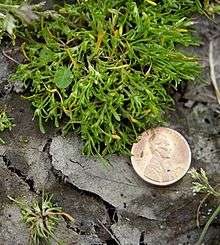Montia howellii
| Montia howellii | |
|---|---|
 | |
| Scientific classification | |
| Kingdom: | Plantae |
| Clade: | Angiosperms |
| Clade: | Eudicots |
| Order: | Caryophyllales |
| Family: | Montiaceae |
| Genus: | Montia |
| Species: | M. howellii |
| Binomial name | |
| Montia howellii | |
| Synonyms[1] | |
| |
Montia howellii is a species of flowering plant in the Montiaceae family known by the common names Howell's miner's lettuce and Howell's montia. It is native to western North America from British Columbia to northern California, where it grows in moist to wet habitat, including vernal pools and meadows. It sometimes grows in shallow standing water such as puddles.
Description
It is a small, low, mat-forming annual herb growing up to about 9 centimeters in maximum length. The linear or lance-shaped, sometimes grasslike, leaves are alternately arranged and measure up to 2.5 centimeters in length. The inflorescence bears 2 to 6 minute flowers with oval green sepals no more than 2 millimeters long and white petals less than a millimeter in length. The flower is usually cleistogamous, self-fertilizing and sometimes never even opening. The species is known from fossilized seeds recovered from sediments of the Pleistocene Tomales Formation (Mason 1932).[2]
References
- ↑ The Plant List: A Working List of All Plant Species, retrieved 8 May 2016
- ↑ Mason, Herbert L. 1932. A Pleistocene Flora from the Tomales Bay Region and Its Bearing on the History of the Coastal Pine Forests of California. University of California, Berkeley, 564 pp.
External links